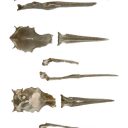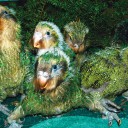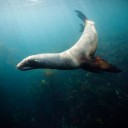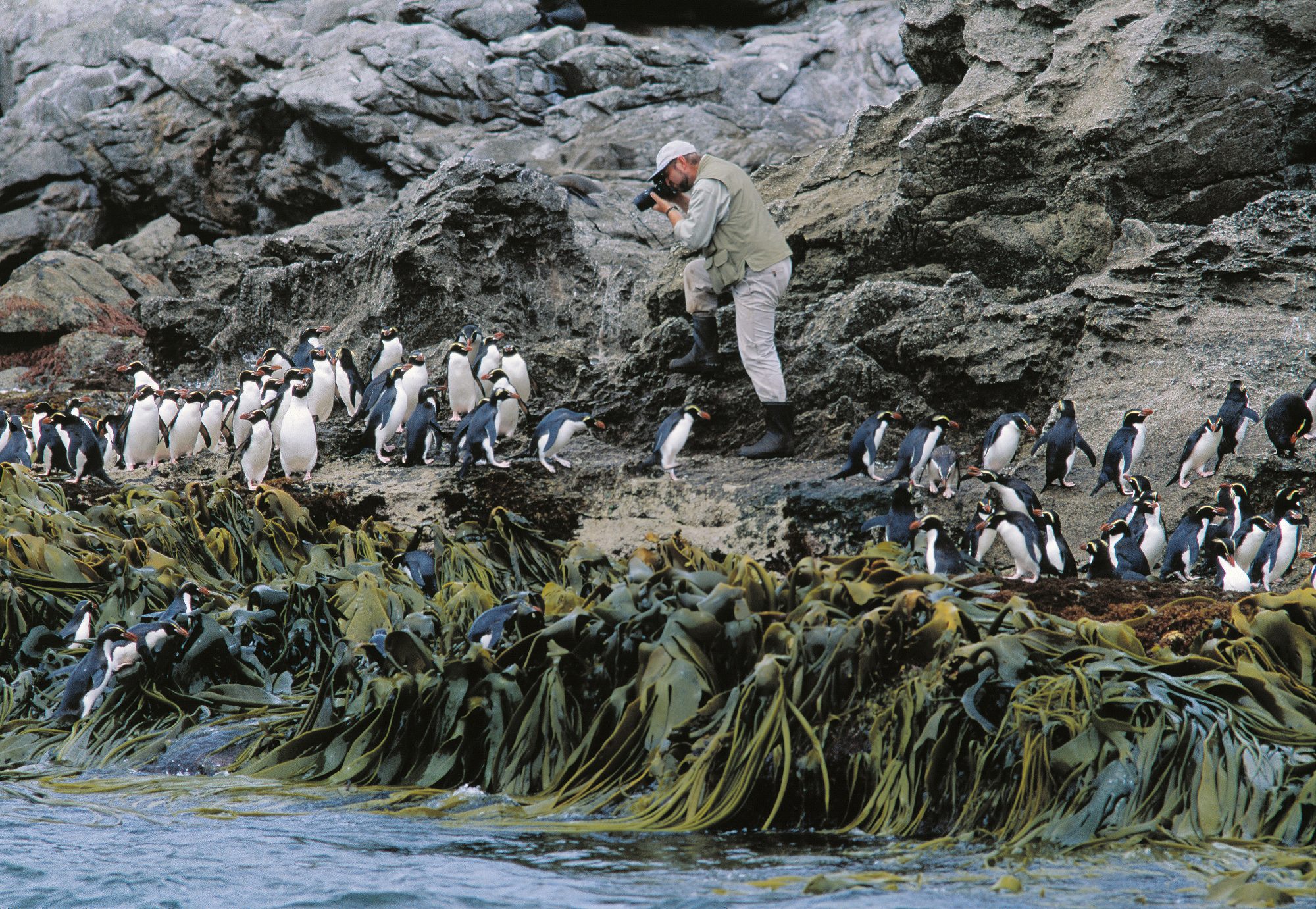
A wing and a Snare. Part 2: Islands of birds
Crops swollen with food for their chicks, sleek Snares crested penguins scramble ashore through slippery kelp, passing National Geographic wildlife photographer Frans Lanting as they make their way to their breeding colonies. Besides penguins, the subantarctic Snares Islands are home to millions of albatrosses, shearwaters, prions and petrels, plus unique landbirds, and are considered one of the least modified terrestrial ecosystems on earth.

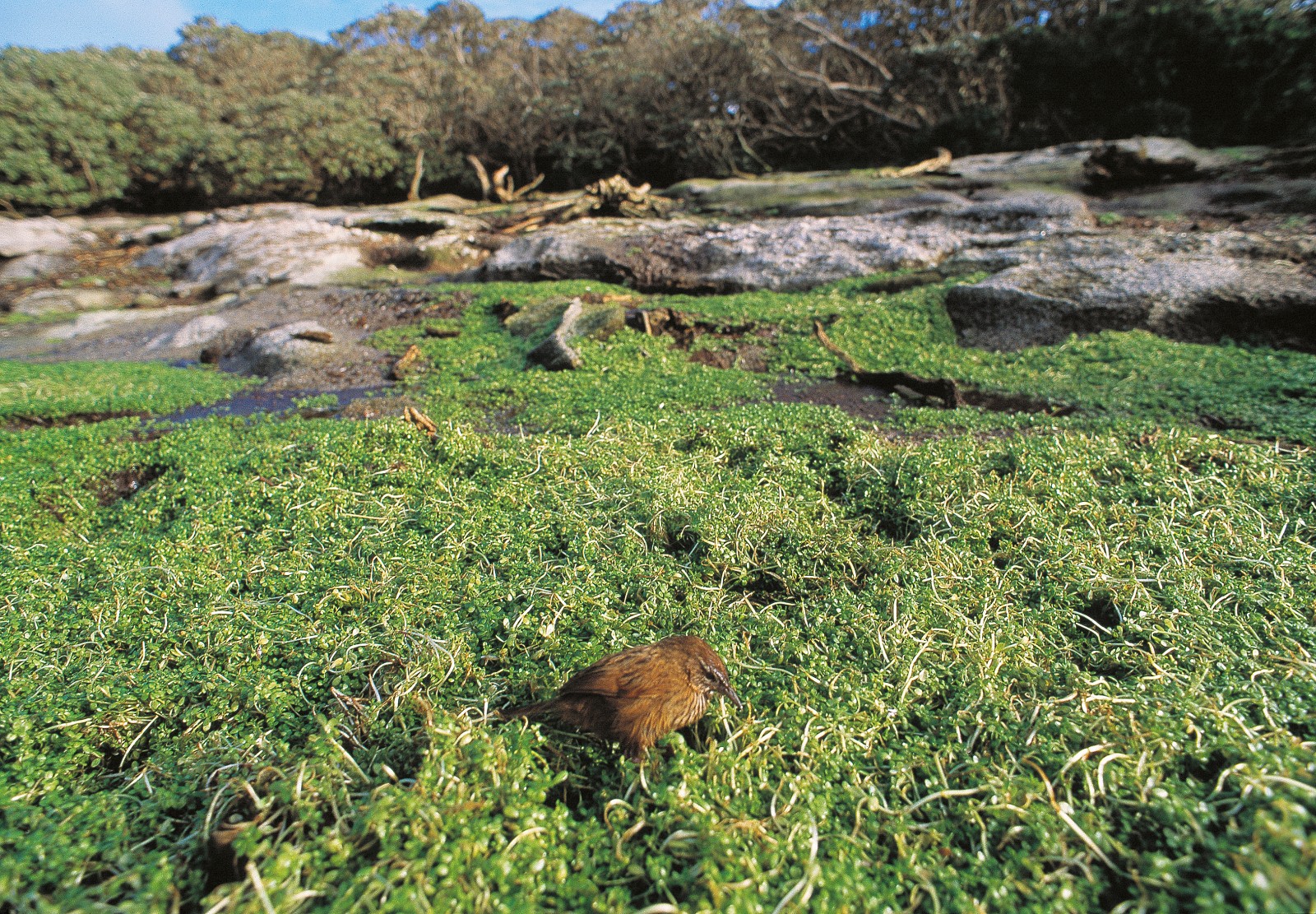
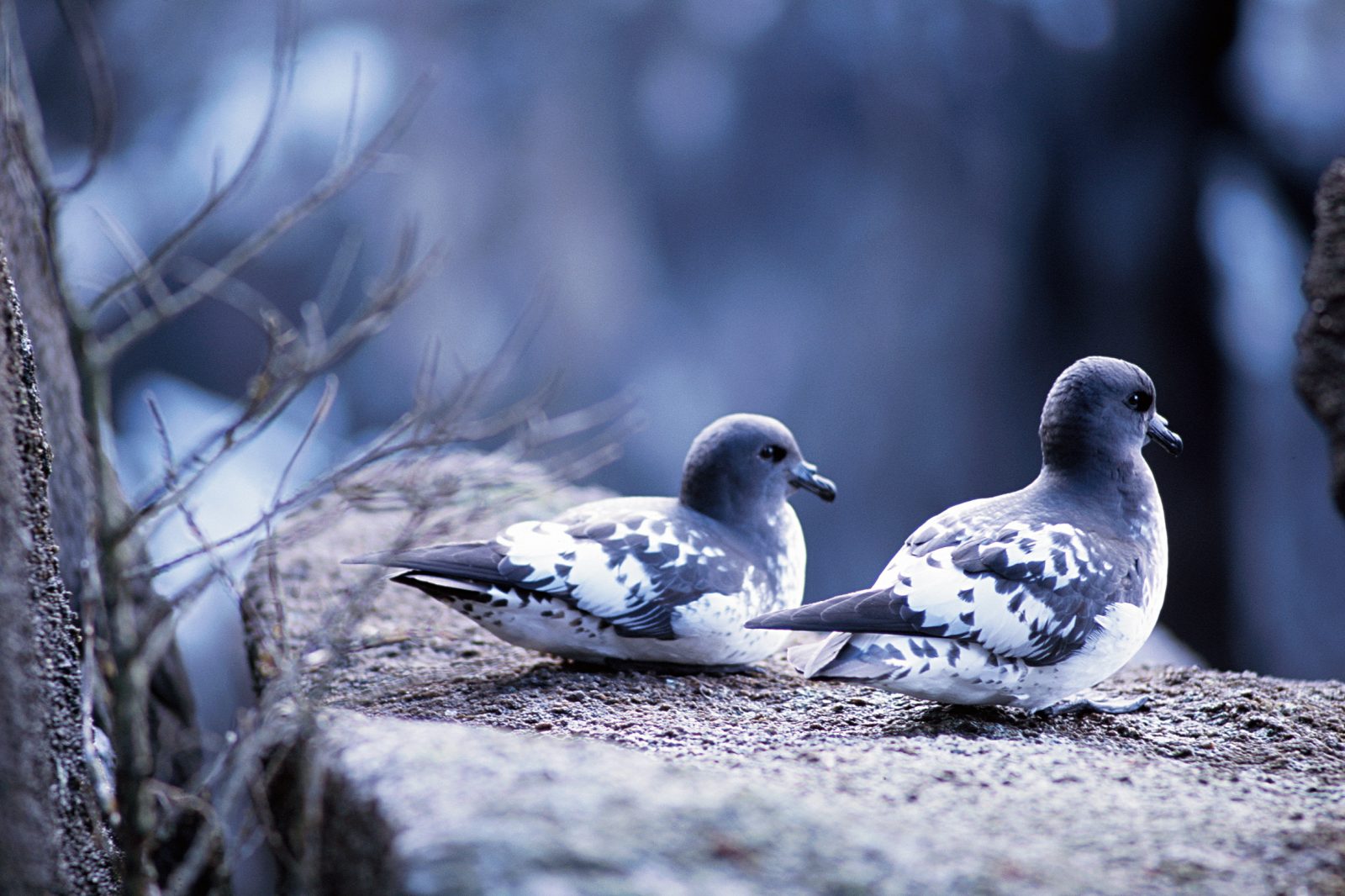
It was my last night on the Snares. I walked back to the research station—a cluster of huts on a forested spur—in the late afternoon, leaving the albatross team to its work of weighing chicks and calculating how much the parent birds were feeding them. During the short winter days of mid-July, the three researchers invariably made the return trip from their study site well after dark, picking their way through the forest by torchlight.
Not far from the huts I branched off the main track—a switchback trail in places knee deep in black peat soup—to look one last time at a pair of sealers’ blubber pots which lie like discarded bowler hats under some trees. Sealers, ever alert to new hunting prospects, first visited the Snares in 1792, scarcely a year after the group’s European discovery, and continued to call on the islands throughout the 1800s.
Aside from the pots, however, there is no visible sign of their having passed this way. No evidence remains, either, of the seven-year stay of a gang of escaped convicts who were exiled on the Snares in 1810. The experience of being abandoned in so desolate a spot mentally unhinged one of the men, which so alarmed his three companions that they pushed him over a cliff. The survivors were eventually picked up by an American whaling ship.
I’m impressed by the fortitude of such men. On a good day, Snares weather can be benign enough—even pleasant—but the islands lie deep in the Roaring Forties, and sailors don’t coin such terms without reason. In 2001, a few months before my first visit, one of the research huts was pushed off its foundations by storm waves. To live seven years in such an unforgiving climate, eating sea lions and penguins plus whatever scrawny potatoes you were able to grow, would challenge the most sanguine constitution.
A tomtit hopped on to the rim of one of the rusty pots and watched me with a bright, quizzical eye. This endemic species of the Snares is lucky to be still in existence. Had rats come ashore with the sealers and established themselves on the islands, the tomtit, along with the rest of the Snares birds, would certainly have disappeared. It is extraordinary the degree to which ecology turns on the throw of the dice. Somehow, the Snares threw a double six, and are today one of the few environments in the world to have escaped human modification.
The first European to see the Snares was George Vancouver, after whom Canada’s Vancouver Island is named. Vancouver had sailed with Cook on his second and third voyages, so was acquainted with New Zealand waters. He was making for Dusky Sound when he was caught in a gale south of Rakiura/Stewart Island. With two metres of seawater in the bilge and his casks of beer and drinking water “stove to pieces,” he was obliged to let his ship Discovery “scud before the wind and sea” while the storm ran its course.
On the morning of November 24, 1791, Vancouver sighted “a cluster of seven craggy islands.” Doubtless relieved that he hadn’t come upon them in the darkness, he named them the Snares, on account of their being “very likely to draw the unguarded mariner into alarming difficulties.” (As with most New Zealand islands, the group already had a Maori name, Tini Heke, of which Vancouver was unaware.)
Vancouver cannot have approached the islands very closely—or perhaps they were shrouded in mist at the time—for he wrote that they were “destitute of verdure.” He couldn’t have been more wrong. Eighty per cent of North East Island (at 280 ha the largest Snare by a factor of five—though little more than a tenth the size of Auckland’s Rangitoto Island) is covered by forest, and much of the remaining 20 per cent by shrubland or tussock. Nearby Broughton Island, named after the captain of Vancouver’s second ship, has a similar mix of vegetation, and even the Western Chain, a string of islets south-west of the two main islands, has at least some tussock cover.
Among New Zealand’s subantarctic islands, only one other group, the Auckland Islands, is forested. There the forest-forming species is rata; in the Snares a species of tree daisy provides a six-to seven-metre-high canopy. The trees have rough, corky ridges of bark running up their branches and large, felted leaves which collect rain water in shirt-drenching quantities—as I found on several occasions when reaching for a branch to climb a slippery section of track.
If the idea of a daisy forest is surprising, what resides within that forest is even more so. Penguins—not the sort of bird one associates with trees and greenery—have their nesting areas in forest clearings and commute to and from the sea along well defined penguin “hiking trails.” On several occasions I was astonished to see them roosting on horizontal branches several metres above ground. They must be the only penguins in the world to climb trees.
Albatrosses, which on other islands tend to nest on exposed open faces, here often raise their young in the shade of the forest—again, a most unusual occurrence. The adults have to walk to cliff edges in order to take off.
There are even larger denizens of the forest than albatrosses. One night, while photographing cave weta, which congregate on the trunks of tree daisies after dark, I heard a soft snoring. My torch found a sea lion with its broad head wedged comfortably in the fork of a fallen tree branch. Day or night, sea lions haul themselves long distances into the forest to snooze.
[Chapter Break]
Though vegetation on the Snares is not in short supply, its diversity is limited. There are only 22 species of higher plant in the entire island group. Botanists puzzle over the floral absentees. Manuka, flax, broadleaf, Dracophyllum and muttonbird scrub—all common on Stewart Island, 100 km away—are missing on the Snares. The Antipodes, just a couple of degrees of longitude further south, have four species of Coprosma shrub; the Snares have none.
An unusual feature of the Snares forest is the lack of an understorey. Beneath the twisted limbs of the daisy trees the soil is bare and as smooth as suede. Compared with, say, Fiordland, where with each footstep you sink into a green luxuriance of mosses, ferns and young saplings, the Snares is like walking in a desert—or on a very thin crust of desert, for underneath the surface lies a catacomb of nests and passages built by the Snares’ commonest bird, the sooty shearwater, titi or muttonbird.
To say muttonbirds are common here fails to convey their overwhelming abundance on the islands. During summer months the sky at dusk is flecked with uncountable numbers of titi returning to their nests from sea. In the morning they gather at various launching points around the coast, forming muttonbird gridlock as they await their turn to take off. As they jostle their way forward in the queues they flap their wings—perhaps to warm up their flight muscles—before swooping across the waves and out to their feeding grounds.
It is unfortunate that the word “muttonbird” has come to be associated with the greasy, strong-flavoured titi chicks cooked and preserved by Maori during the annual titi harvest on offshore islands around Stewart Island. The birds deserve better public awareness than simply as an item of indigenous cuisine. They are avian high achievers. Adult muttonbirds regularly dive to more than 40 m in search of food (the deepest recorded dive is 67 m) and migrate each year to Alaska, the Aleutian Chain and California. During chick-rearing Snares adults have been recorded as travelling 1150 km from their nests in search of productive feeding grounds before returning with food for their young.
In 1982, zoologists John Warham and Graham Wilson estimated that there were 3,287,000 titi burrows on the Snares. Assuming a 75 per cent occupancy rate, they came up with a figure of 2,750,000 pairs of birds—some 4400 tonnes of flesh and feather. In the paper in which they reported their findings the authors stated: “[The Snares] supports a bird population similar in size to that of the whole of the seabird population of Britain and Ireland.” Little wonder New Zealand is regarded as the seabird capital of the world.
[Chapter Break]
Beside sooty shearwaters and southern Buller’s albatrosses (see part one of this article in New Zealand Geographic Issue 61), the Snares have breeding populations of southern diving petrels, mottled petrels, Salvin’s albatrosses (on two islets in the Western Chain), Snares Cape pigeons, Antarctic terns and three species of prion—some three million birds in all, living in an area of about three square kilometres.
The islands’ only endemic seabird is the Snares crested penguin, which stands a little less than knee high and has a jazzy yellow head-crest, a tangerine-coloured bill, pink feet and smart black-and-white plumage. (A small number of birds display a phenomenon called isabellinism, in which the back feathers are pale fawn.)
Snares crested penguins have an unusual breeding strategy in that the females lay two eggs but only one chick is reared. The second egg is laid four to five days after the first, and is larger, but the surviving chick may come from either egg. It is thought that the two-egg strategy is a hedge against loss of an egg or chick to storms or predation by skuas.
Penguin colonies are noisy, smelly, muddy places where up to 2000 birds may be packed sardinelike into an open space in the forest. The air is regularly split by fortissimo braying calls, often begun by a single bird and immediately drawing a chorus of responses from those nearby. Ornithologists call this “contagious trumpeting.”
In colonies situated on areas of soil the nests can be up to 15 cm high. Penguins (predominantly the males) make a shallow depression by pushing back the soil with their feet while they rotate on their bellies. They then add bits of vegetation, bones, debris and beakfuls of mud to raise the nest rim above ground level. Where colonies are on bare rock, the nests are little more than a few bits of twig thrown together in facsimile of a nest. Sometimes, early in the season, if a penguin has second thoughts about where it has built its nest, it moves it twig by twig to a new location.
To reach the colonies, penguins must walk up to a kilometre along twisting forest trails made muddy by the footfalls of thousands of commuting birds. Perhaps the most difficult commute is that made by birds whose colony is near a massive rock scar called Penguin Slope.
This area of bare granite is 100 m long, 50 m wide and 40 degrees to the horizontal. Penguins must climb the slope to reach the colony, which is on a flatfish area above it, then make the equally difficult descent to return to sea.
At the edge of one penguin colony I visited in December 2002, a single Auckland Island shag had built a large tussock nest under some stunted tree daisies. Albatross researcher Jean-Claude Stahl told me the shag had occupied the site each breeding season for five years, vainly waiting for a mate. (Its chances were slim; the species breeds only in the Auckland Islands, 270 km due south.) Stahl and others had noticed that, while in residence with the penguins, the shag adopted the habit of walking to and from the sea like its flightless companions. At the end of the breeding season, when the penguins left the island, the shag started flying again.
The shag’s presence illustrates a problem—perhaps the major problem faced by the Snares, short of a catastrophe such as an oil spillage or the introduction of a mammalian predator: vagrancy. Because the islands are so close to the mainland (via the stepping stone of Stewart Island) and downwind of Australia they are vulnerable to colonisation by any avian Tom, Dick or Polly which happens to get blown in their direction.
Some 50 vagrants have so far been recorded, including various finches and gulls, godwits, mallards, Canada geese, a Japanese snipe, two tree martins, a few grey warblers and three racing pigeons. Even a morepork has been heard—the only documented incidence of that bird on any subantarctic island.
Already, some of the self-introduced foreigners are breeding. Fantails are now the third commonest passerines on the Snares, behind the endemic Snares tomtit and fernbird. Silvereyes, chaffinches, redpolls, song thrushes and blackbirds have all formed populations of varying sizes, and are no doubt competing with the three endemic landbirds. Homo sapiens casts a long shadow. Birds released by settlers on mainland New Zealand now threaten to disrupt an ecosystem far away in the Southern Ocean. Difficult management decisions may lie ahead for the Department of Conservation if it is to preserve the integrity of the Snares’ flora and fauna.
For now, though, life on the islands goes on much as it has done for millennia. The penguins arrive each year in late August, the muttonbirds in September and the southern Buller’s albatrosses in December. Each species has its cycle of courtship, mating and chick-rearing, and in the process replenishes the fertility of the islands’ soil with ample deposits of guano.
By late October the following year the albatross chicks, the last of the seabirds to leave the islands, will have departed. They will not return again—will not touch land at all—for at least five years. As I waited for the Southern Express to pick me up, I watched the parent birds soaring in their hundreds across the horizon. Maori speak of a people’s turangawaewae, their ancestral home, their “place to stand.” The Snares are these birds’ turangawaewae. I hope we can keep it that way.








